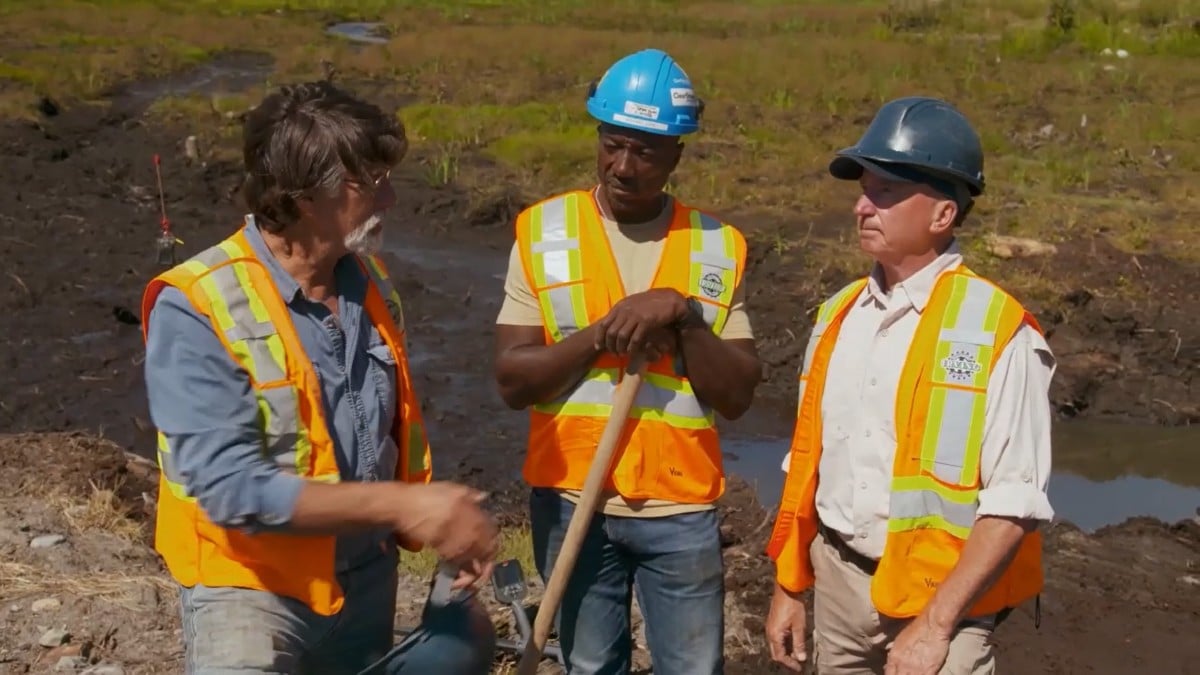
This week on The Curse of Oak Island, the team consulted a marine archaeologist about the artifacts found in the swamp, and Gary Drayton’s metal detector actually picked up on an ancient coin.
The guys just can’t stop finding artifacts in the swamp. Both Rick and Marty Lagina pointed out early on in last night’s episode that every time they go digging in the boggy land they find something. These finds range from ancient tools to ship’s railings and decking, to an actual stone roadway and a ship’s wharf.
Later in the episode, Dr. Ian Spooner referred to the swamp as a “book” because they find something significant every time they look into it. And it was no different yesterday, as Gary Drayton and Billy Gerhardt continued to pull various pieces of wood out of the marshy land.
Unfortunately, Gary still doesn’t have a wood dance to accompany his “gold dance,” but he still couldn’t hide his excitement over the variety of interesting items they were uncovering.
Dr. Lee Spence expected the Oak Island artifacts
The guys decided it was time to have an expert look at all these artifacts, so they welcomed Marine Archaeologist Dr. Lee Spence to the War Room, hoping that he would impart some wisdom. The team is still hoping that an ancient treasure ship is buried in the swamp, and they mainly wanted Lee to let them know if these artifacts were nautical in origin.
Lee has spent a lifetime researching maritime history, and he found his first wreck on a dive when he was just 12 years old, so there was no doubting his credentials. And he told the guys exactly what they wanted to hear. Most of the items found “could easily be part of a ship,” he said.
There was one item that looked like a rather large wooden pin, which Lee said was likely a “fid.” Fids were used to manipulate rope on sailing ships, and he said this one probably came from a large sailing ship.

Later in the episode, the team received the results of some carbon dating tests they’d ordered on a couple of the swamp items, and, excitingly, they were dated from approximately 1680 to 1750.
These dates, or similar, keep cropping up in the course of their research, and everyone is starting to believe that something of great significance happened on Oak Island sometime between 160 and 1750.

There was excitement over a coin find, but disappointment at the Money Pit
Meanwhile, Gary Drayton actually found a coin, and no, it wasn’t a Canadian dollar. Yes, you read that right! The metal detectorist, along with Michael John, were exploring lot 32 (near the swamp by the coast) when they found the circular coin-like object.
Gary thought it looked very similar to two British 17th-century coins the guys found in 2018. But, he resisted the urge to scrape the dirt off for fear of damaging it and sent it off to the archaeology trailer for proper study. We’ll hopefully hear the results of that next week.

Regulars of the show will know you can’t have a high without a low on Oak Island; with that in mind, it was perhaps no surprise that there was a major disappointment at the Money Pit. Last week, there was lots of excitement when they thought they’d hit a cavity that may have been a secret chamber.
And their excitement was again piqued last night when the drill appeared to hit the cavity once again. However, disappointment crept into their faces when a core sample pulled up some eelgrass; this organic material was used with coconut fiber in the construction of flood tunnels. This meant the cavity was unlikely to be a secret chamber stuffed with treasure but was probably a boring old flood tunnel.
The Curse of Oak Island airs at 9/8c on History.
Dragging this out way tooooooo long!
fid is probably a thole pin used as a fulcrum for rowing a small rowboat, trapezoidal wood piece probably is part of a forward seat om the same and the small “rope-burned” piece could be a mast wedge used to secure the mast of a small boat usually through a seatthink smaller than a ship!